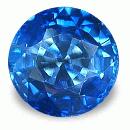|
|
|
|
Click on a letter above to view the list of gems. |
|
|
|
|
|
Sapphire
(variety
of Corundum) |
|
| Chemistry: Al2O3 + Fe,Ti,Cr [Aluminum Oxide] | |
| Discovered
in Prehistory;
IMA
status: Corundum is Valid (pre-IMA; Grandfathered). | ||
|
| ||
|
Classification |
|
|
| |
|
Oxides | |
|
4/C.04-10 | |
|
|
4 : OXIDES (Hydroxides, V[5,6] vanadates, arsenites, antimonites,
bismuthites, sulfites, selenites, tellurites, iodates) |
|
Related to: |
Hematite Group. The aluminum analogue of Eskolaite, Hematite, and Karelianite. The red (Cr-bearing) gem variety is called Ruby. |
|
|
|
|
Crystal Data |
|
|
|
|
|
Crystals hexagonal, prismatic or steeply dipyramidal, tabular, rhombohedral, rarely acicular, typically rough, to 1 m; sectorially striated on [0001] k [1011]. Also granular, massive. |
|
|
Common lamellar k [1011], may be an exsolution phenomenon. Contact or penetration twins on [0001] or [1011], rare. |
|
|
|
|
|
Physical Properties |
|
|
|
|
|
None; Partings on [0001] and [1011] |
|
|
Irregular/Uneven, Conchoidal |
|
|
Brittle |
|
|
9.0 |
|
|
3.99 - 4.10 (g/cm3) |
|
|
None |
|
|
Not Radioactive |
|
|
|
|
|
Optical Properties |
|
|
|
|
|
Colorless, Gray, Brown, Pink, Orange, Yellow, Green, Blue to Cornflower Blue, Violet; may be color zoned, asteriated |
|
|
Transparent to Translucent, Opaque |
|
|
Adamantine to Vitreous, Pearly on partings |
|
|
1.760 - 1.772 Uniaxial ( - ); commonly anomalously Biaxial |
|
|
0.008 - 0.009 |
|
|
0.018 (low) |
|
|
Weak; e = blue-green to yellow-green, o = pale to deep blue |
|
|
Other: |
Asterism often present due to oriented needle-like inclusions or to colloidal or other material deposited in oriented tubules. |
|
|
|
|
Occurances |
|
|
|
|
|
Geological Setting: |
Characteristic of Al-rich, Si-poor geological environments; in syenite and monzonite, and some quartz-free pegmatites; primary or a reaction product in eclogitic xenoliths in kimberlites. In regional or contact, high-grade metamorphic aluminous rocks, and some advanced argillic and potassic hydrothermal alteration assemblages; detrital in placers. |
|
Common Associations: |
Andesine, Oligoclase, Nepheline, Scapolite (syenites); Spinel, Rutile, chondrodite, “Hornblende”, Phlogopite, Calcite (metamorphosed limestones); Kyanite, Sillimanite, Dumortierite, Chlorite (schists); Pyrope-rich Garnet, Spinel, Phlogopite, Omphacitic Clinopyroxene, Kyanite, Rutile, Graphite, Diamond (eclogitic xenoliths). |
|
Common Impurities: |
Cr, Fe, V, Ti |
|
Type Locality: |
None; Prehistoric |
|
Year Discovered: |
Prehistoric |
|
View mineral photos: | |
|
|
|
|
More Information |
|
|
|
|
|
|
Mindat.org
(Sapphire) |
|
|
|
|
Sapphire is available from many locations
around the world. Some of these locations, like Cambodia,
Ceylon and Kashmir, are well known for their
fine Sapphires. |
|
|
We
have not photographed our Sapphire
gems. Please
check back soon. |
